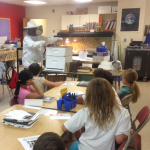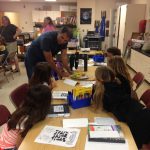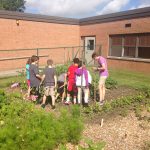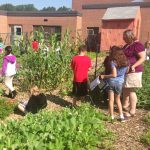Plant Anatomy & Genetics
Raspberry plants are used by Courtney Weber (Horticultural Sciences) as an example of how traits such as berry color and leaf morphology are passed along from parent to progeny. The kids also learn that all cells contain deoxyribonucleic acid (DNA).
Entomology
The entomologists are among the most popular visitors since the students really enjoy learning about insects. An entomologist discusses insect biology and explains the difference between beneficial and detrimental insects commonly found in vegetable gardens. The students then each catch an insect and try to determine if it is beneficial or detrimental. Many pest insects are seen in the gardens including cabbage aphids, squash vine borers, and leafhoppers. Beneficial insects include lady bird beetles, bumble bees and lace wings. A local beekeeper also comes in to talk about keeping bees.
Plant Diseases
Plants can get sick too, but the germs or microbes that make plants sick are different from those that make people sick. Chris Smart works with the students during this week to understand the diseases in the gardens. Using Petri dishes filled with agar, students culture the gray mold fungus from diseased strawberries. Healthy strawberries are used as a control, and everyone learns that even clean, healthy strawberries have some fungus on them.
Food Science
Betsy Bihn (Food Science) demonstrates proper hand washing technique using glo-germ, a lotion which glows under ultraviolet light. Children make predictions as to how well different hand washing techniques will work. The use of ‘good microbes’ to make many foods such as yogurt, bread and brie, is also explored (as well as tasted).




